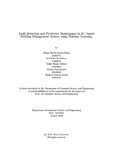| dc.contributor.advisor | Chakrabarty, Amitabha | |
| dc.contributor.author | Sabuj, Khaja Sheikh Imran | |
| dc.contributor.author | Chowdhury, Saifullah | |
| dc.contributor.author | Mehedi, Fahim Hasan | |
| dc.contributor.author | Chakraborty, Pritam | |
| dc.contributor.author | Arnob, Shafarse Simeon | |
| dc.date.accessioned | 2022-05-11T08:43:36Z | |
| dc.date.available | 2022-05-11T08:43:36Z | |
| dc.date.copyright | 2022 | |
| dc.date.issued | 2022-01 | |
| dc.identifier.other | ID 16201071 | |
| dc.identifier.other | ID 17201057 | |
| dc.identifier.other | ID 17201108 | |
| dc.identifier.other | ID 21141083 | |
| dc.identifier.other | ID 16101235 | |
| dc.identifier.uri | http://hdl.handle.net/10361/16595 | |
| dc.description | This thesis is submitted in partial fulfillment of the requirements for the degree of Bachelor of Science in Computer Science and Engineering, 2022. | en_US |
| dc.description | Cataloged from PDF version of thesis. | |
| dc.description | Includes bibliographical references (pages 33-35). | |
| dc.description.abstract | Infrastructures in the modern era are incorporating the Internet of Things (IoT) in
everything from complex building automation systems (BAS) to individual small
devices, emphasizing the importance of Predictive Maintenance. As a result, early
fault detection is required, especially in sensitive and massive structures such as
hospitals, industries, and multipurpose buildings. In such infrastructures, even minor
failures can result in tragedies such as fires or slow down productivity. In
our research, we have used several machine learning fault detection and diagnostics
(FDD) algorithms in building fault detection data. We collected two datasets,
MZVAV-1 (SET-A) and MZVAV-2-1 (SET-B), which were split into train-test sets
to deploy LogisticRegression, KNearestNeighbours, Naive Bayes classifier, Support
Vector Classifier, RandomForestClassifier, Decision Tree, MLP Classifier and Extra
Tree Classifier. We achieved the highest accuracy of 98.91% using the Decision
Tree classifier and the lowest accuracy of 14.17% from Naive Bayes classifier on the
MZVAV-1 dataset. RandomForestClassifier and ExtraTree classifier outperformed
all other algorithms with 99.91% accuracy on the MZVAV-2-1 dataset. | en_US |
| dc.description.statementofresponsibility | Khaja Sheikh Imran Sabuj | |
| dc.description.statementofresponsibility | Saifullah Chowdhury | |
| dc.description.statementofresponsibility | Fahim Hasan Mehedi | |
| dc.description.statementofresponsibility | Pritam Chakraborty | |
| dc.description.statementofresponsibility | Shafarse Simeon Arnob | |
| dc.format.extent | 35 pages | |
| dc.language.iso | en | en_US |
| dc.publisher | Brac University | en_US |
| dc.rights | Brac University theses are protected by copyright. They may be viewed from this source for any purpose, but reproduction or distribution in any format is prohibited without written permission. | |
| dc.subject | IoT | en_US |
| dc.subject | Fault detection | en_US |
| dc.subject | Building systems | en_US |
| dc.subject | FDD algorithms | en_US |
| dc.subject | Predictive maintenance | en_US |
| dc.subject.lcsh | Internet of things | |
| dc.subject.lcsh | Machine learning | |
| dc.title | Fault detection and predictive maintenance in IoT-based building management system using machine learning | en_US |
| dc.type | Thesis | en_US |
| dc.contributor.department | Department of Computer Science and Engineering, Brac University | |
| dc.description.degree | B. Computer Science | |

